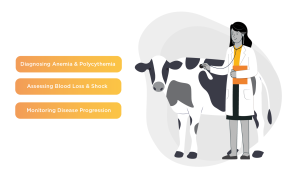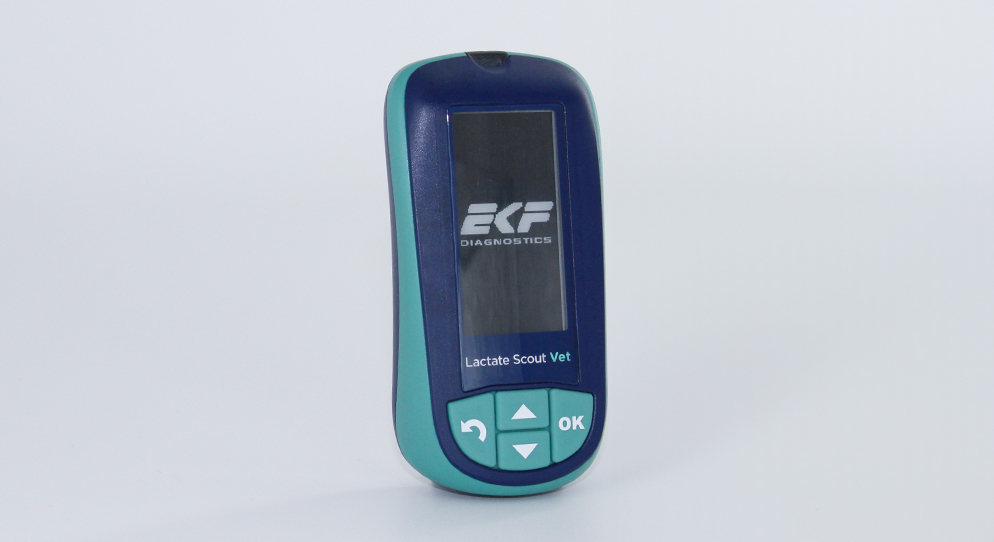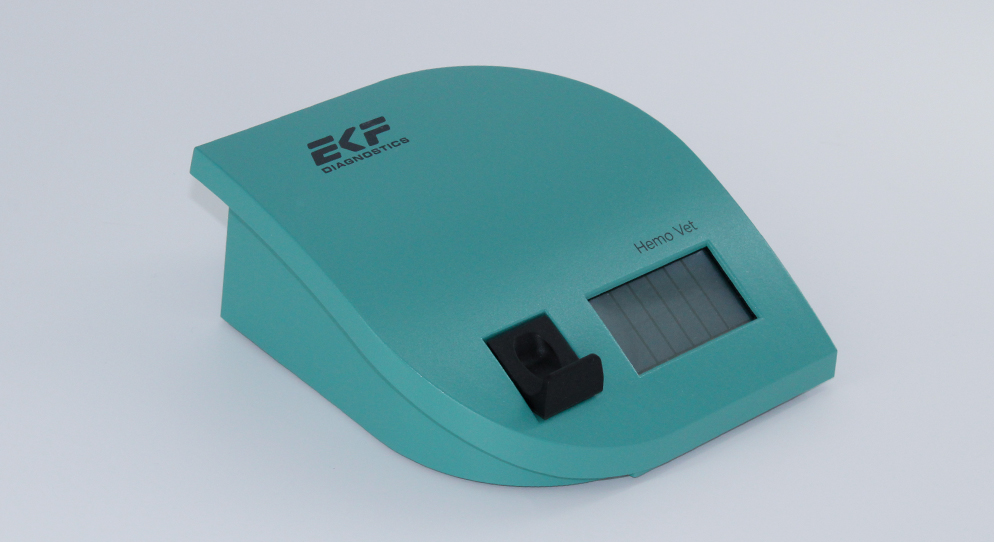Point-of-Care Diagnostics in Veterinary Medicine
Veterinary diagnostics are crucial for early disease detection, treatment monitoring, and performance evaluation. With the advent of handheld analyzers, veterinarians now have access to rapid, reliable, and cost-effective point-of-care (POC) testing, particularly for lactate and hemoglobin levels.
This guide covers lactate testing in veterinary practice, including its role in small animals, large animals, and equine performance, as well as the importance of hemoglobin testing in assessing anemia, infections, and metabolic disorders.
Lactate Testing in Veterinary Medicine
Lactate, a byproduct of anaerobic metabolism, is a key biomarker for hypoxia, tissue perfusion, and disease severity. Though a single lactate measurement isn’t diagnostic, serial monitoring offers valuable insights into disease progression and treatment response.
Why Measure Lactate?

Lactate testing is widely used in veterinary medicine for:
- Triage & Prognosis – Helps assess critically ill patients (e.g., sepsis, trauma, cardiac complications).
- Treatment Monitoring – Tracks response to interventions and aids in decision-making.
- Surgical & Postoperative Care – Evaluates recovery from major surgeries.
Normal lactate levels are typically <2.0 mmol/L, with higher values indicating poor perfusion, shock, or metabolic distress.[1] However, false elevations can occur due to stress, venous occlusion, or improper handling.
Lactate Testing in Small Animals
Lactate testing is widely applied in small animals for diagnosing and monitoring conditions such as:
- Gastric Dilatation-Volvulus (GDV): High lactate correlates with severity and gastric necrosis.
- Lymphoma: Dogs with lymphoma exhibit elevated lactate levels.
- Sepsis & Infections: Increased lactate suggests poor prognosis in septic peritonitis, babesiosis, and septic arthritis.
- Postpartum Distress: Persistently high lactate in puppies correlates with higher morbidity.
- Cardiac & Respiratory Diseases: Elevated lactate is linked to cardiac effusion and abnormal thoracic X-rays.
- Heatstroke & Trauma: Higher lactate at 12 hours post-heatstroke or head trauma signals increased mortality risk.
- Surgical Recovery: Postoperative lactate levels help predict complications in cholecystectomy and pyometra cases.
Clinical Significance
- A normal lactate level (<2.0 mmol/L) is a strong predictor of survival.[2]
- Serial lactate measurements are more informative than a single test—a declining trend suggests improvement, while persistently high values indicate worsening conditions.
Lactate Testing in Large Animals
Lactate testing is increasingly used in farm animals to assess neonatal health, disease severity, and welfare monitoring.[3]
Applications in Cattle and Sheep
- Neonatal Health: High lactate levels indicate severe diarrhea, respiratory distress, and abomasal displacement in calves.
- Dystocia & Newborn Viability: Calves born via assisted delivery (dystocia) show higher lactate, correlating with lower APGAR scores.
- Pregnancy & Fitness: Helps assess pregnant cows’ health and readiness for calving.
- Meat Quality & Welfare: In pigs, pre-slaughter lactate levels correlate with stress and pork quality.
Advancements in POC Lactate Testing
Traditional lactate testing required laboratory analysis, but handheld analyzers now provide accurate, real-time results in the field.
Studies Validating POC Lactate Testing
- Freie Universität Berlin: Found handheld lactate analyzers reliable for measuring dystocia-associated lactate levels in cows.[4]
- Ataturk University, Turkey: Validated POC lactate testing in sheep, showing 98% accuracy and 99% precision compared to lab methods.[5]
Lactate Testing in Equine Performance
Lactate is a key biomarker in assessing fitness, endurance, and recovery in performance horses.
Understanding Lactate in Exercise
During low-intensity exercise, aerobic metabolism dominates. As intensity increases, anaerobic metabolism takes over, producing lactate. Horses cannot directly use lactate for energy, so blood lactate levels indicate the shift to anaerobic metabolism.
Assessing Fitness with Lactate Testing
Step Exercise Tests (SETs) track lactate levels at rest, during exercise, and post-exercise to:
- Measure anaerobic threshold (VLa4) – the speed at which lactate reaches 4 mmol/L.
- Identify training adaptations – Lower lactate at the same speed = improved fitness.
- Monitor recovery – Faster lactate clearance = better conditioning.
Key Performance Insights
- Horses with higher VLa4 values can sustain higher speeds before lactate accumulation, indicating better endurance.
- Post-exercise lactate clearance over 1–2 hours reflects metabolic recovery and fitness level.
- Blood sampling technique: Requires careful capillary blood collection to ensure accurate readings.
Fact: Resting lactate levels in horses (1.5–2 mmol/L) are similar to humans, but post-exercise levels exceed 20 mmol/L, compared to 10 mmol/L in humans.[6]
Hemoglobin Testing in Veterinary Medicine
Hemoglobin (Hb) is an oxygen-binding protein in red blood cells, essential for oxygen transport and metabolic function. Hb levels vary across species, breed, and age, and imbalances can indicate disease.[7]
Why Test Hemoglobin?

- Diagnosing Anemia & Polycythemia
- Assessing Blood Loss & Shock
- Monitoring Disease Progression
Clinical Conditions Associated with Hb Levels
- Anemia: Low Hb suggests blood loss, chronic disease, or marrow failure
- Sepsis: Correlation between Hb, methemoglobin, and disease severity
- Babesia gibsoni: Hb used as a prognostic marker
- Gastric Ulcers: Hb drops 10 days post-ulceration[8]
- Heartworm Disease: Severe cases show decreased Hb[9]
- Aging: Dogs over 10 years old show gradual Hb decline[10]
- Congestive Heart Failure: Lower Hb linked to worse outcomes
- Sarcoptic Mange: Moderate & severe infections reduce Hb
Advancements in Hemoglobin Testing
- Handheld Hb analyzers like Hemo Vet allow rapid, field-based testing.
- Venous vs. capillary samples offer comparable results for on-site decision-making.
Summary
Point-of-care diagnostics, particularly lactate and hemoglobin testing, provide rapid, reliable insights into animal health and performance.
- Lactate testing is invaluable for triage, disease monitoring, and athletic performance assessment.
- Hemoglobin testing aids in diagnosing anemia, infections, and metabolic disorders.
With portable analyzers, veterinarians can now conduct real-time, evidence-based assessments, leading to improved clinical outcomes for companion animals, livestock, and equine athletes.
Sources:
[1] Muir, W. W., & Hubbert, J. M. (2017). Lactate and lactate testing in veterinary medicine. In Veterinary Anesthesia and Analgesia (5th ed.). John Wiley & Sons, Inc.
[2] Cell-Free DNA, High-Mobility Group Box-1, and Procalcitonin Concentrations in Dogs With Gastric Dilatation-Volvulus Syndrome.
Front Vet Sci. 2018 Apr 9;5:67
[3] Burfeind and Heuwieser (2012). Validation of handheld meters to measure blood L-lactate concentration in dairy cows and calves. Journal of Dairy Science. 95: 6449–6456 https://www.journalofdairyscience.org/article/S0022-0302(12)00648-0/fulltext
[4] Burfeind and Heuwieser (2012). Validation of handheld meters to measure blood L-lactate concentration in dairy cows and calves. Journal of Dairy Science. 95: 6449–6456 https://www.journalofdairyscience.org/article/S0022-0302(12)00648-0/fulltext
[5] Baydar et al (2015). Reliability of the Lactate Scout point-of-care instrument for the determination of blood L-lactate concentration in sheep. Veterinary Clinical Pathology.; 44: 559–563 https://onlinelibrary.wiley.com/doi/abs/10.1111/vcp.12288
[6] Kobayashi, M. (2007) Journal of Equine Science 18(1):5-11
[7] Brenten et al 2016: Study showing the importance of reference ranges based on both breed and age in dogs. https://www.ncbi.nlm.nih.gov/pmc/articles/PMC4879334/pdf/vetreco-2015-000166.pdf
[8] Elfadadny et al 2021: Hb concentrations start to decrease at 10 days post ulceration. https://www.ncbi.nlm.nih.gov/pmc/articles/PMC8478067/pdf/JVIM-35-2196.pdf
[9] Kim et al 2020: Decreased Hb is associated with dogs severely affected by heart worm disease. https://www.ncbi.nlm.nih.gov/pmc/articles/PMC7491002/pdf/cjvr_04_265.pdf
[10] Pati et al 2015: Decreased Hb concentration as dogs age past 10 years of age. https://www.ncbi.nlm.nih.gov/pmc/articles/PMC4774830/pdf/VetWorld-8-273.pdf
NOTE: this guide is for information purposes only, and is not intended for use in patient diagnostics, screening, monitoring, or for making treatment decisions.







